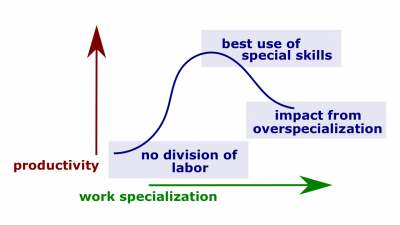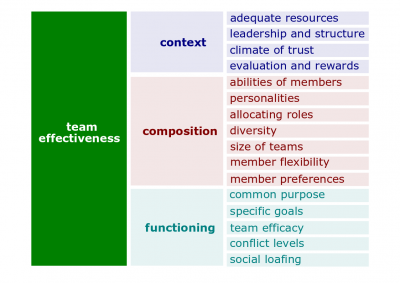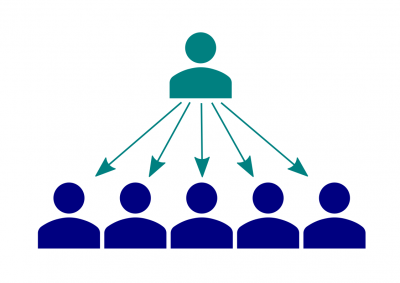Difference between revisions of "Workforce Arrangements Quarter"
(→Concepts) |
(→Concepts) |
||
| Line 43: | Line 43: | ||
#*[[Job depth]]. The degree of control employees have over their work. | #*[[Job depth]]. The degree of control employees have over their work. | ||
#*[[Job score]]. The number of different tasks required in a job and the frequency with which those tasks are repeated. | #*[[Job score]]. The number of different tasks required in a job and the frequency with which those tasks are repeated. | ||
| − | #'''[[Occupational nature]]'''. | + | #'''[[Occupational nature]]'''. The main characteristic of an [[occupation]]. This characteristic impacts preferences for work environments and [[outcome]]s. |
===Roles=== | ===Roles=== | ||
Revision as of 20:47, 17 January 2019
Workforce Arrangements Quarter (hereinafter, the Quarter) is a lecture introducing the learners to team design primarily through key topics related to workgroup design. The Quarter is the third of four lectures of Team Quadrivium, which is the sixth of seven modules of Septem Artes Administrativi (hereinafter, the Course). The Course is designed to introduce the learners to general concepts in business administration, management, and organizational behavior.
Contents
Outline
Regulatory Сompliance Quarter is the predecessor lecture. In the enterprise design series, the previous lecture is User Experience Quarter.
Concepts
- Workforce arrangement. The action, process, or result of arranging or being arranged that an enterprise does for and/or offers to its various workgroups and/or workteams.
- Enterprise workforce.
- Workforce diversity. (1) The ways in which people in an enterprise are different from and similar to one another; (2) The concept that enterprises are becoming more heterogeneous in terms of gender, age, race, ethnicity, sexual orientation, and other characteristics.
- Decision-making authority design.
- Decentralization. The degree to which lower-level employees provide input or actually make decisions.
- Centralization. The degree to which decision-making is concentrated at a single point, usually at upper levels, in an organization.
- Workgroup. A group that interacts primarily to share information and to make decisions to help each group member perform within his or her area of responsibility.
Productivity criteria Interacting group Brainstorming group Nominal group Electronic group Ideas Number and quality of ideas Low Moderate High High Groupthink Social pressure High Low Moderate Low Expenses Money costs to form the group Low Low Low Moderate Speed Speed of group operations Moderate Moderate Moderate Moderate Consistency Task orientation Low High High High Conflict Potential of interpersonal conflict High Low Moderate Low Commitment Commitment to solution High Not applicable Moderate Moderate Cohesiveness Development of group cohesiveness High High Moderate Low - Group functioning. The quantity and quality of a group's work output.
- Social loafing. The tendency for individuals to expend less effort when working collectively than when working individually.
- Group decision-making. Decision-making made by a group as opposed to individual decision-making.
Decision-making Individual decision-making Group decision-making Ideas Number and quality of ideas Varies; tends to be moderate High Groupthink Social pressure Not applicable Varies; tends to be high Expenses Money costs to form the group Not applicable Low Speed Speed of group operations Varies; tends to be high Moderate to low Consistency Task orientation Varies; tends to be high Varies; tends to be moderate Conflict Potential of interpersonal conflict Not applicable Varies; tends to be high Commitment Commitment to solution Varies; tends to be moderate Varies; tends to be high
- Role. A set of expected behavior patterns attributed to someone occupying a given position in a social unit.
- Role ambiguity. When role expectations are not clearly understood.
- Role expectations. How others believe a person should act in a given situation.
- Role overload. Having more work to accomplish than time permits.
- Role perception. An individual's view of how he or she is supposed to act in a given situation.
- Workteam. (1) A group whose members work intensely on a specific, common goal using their positive synergy, individual and mutual accountability, and complementary skills; (2) A group whose individual efforts result in performance that is greater than the sum of the individual inputs.
Comparison criteria Workgroup Workteam Goal Information sharing Collective performance Synergy Neutral (sometimes, negative) Positive Accountability Individual Both individual and mutual Skills Random and varied Complementary - Self-managed workteam. (1) A workteam that operates without a manager and is responsible for a complete work process or segment; (2) A workteam usually of 10 to 15 people who take on responsibilities of their former supervisors.
- Virtual team. A workteam that uses computer technology to link physically dispersed members in order to achieve a common goal.
- Problem-solving team. A workteam usually of 5 to 12 employees from the same department of functional area who meet often for a few hours each week to discuss ways of improving work activities or solve specific problems such as quality, efficiency, and the work environment.
- Cross-functional team. A workteam composed of employees from about the same hierarchical level, but from different work areas, who come together to accomplish a task.
- Cross-hierarchical team. A workteam composed of employees from different hierarchical levels.
- Team characteristic.
- Reflexivity. A team characteristic of reflecting on and adjusting the master plan when necessary.
- Mental model. Team members' knowledge and beliefs about how the work gets done by the team.
- Team efficacy. A team's collective belief that they can succeed at their tasks.
- Team identity. A team member's affinity for and sense of belongingness to his or her team.
- Job design. The way tasks are combined to form complete jobs or, in other words, the way the elements in a job are organized.
- Proactive perspective of work design. An approach to job design in which employees take the initiative to change how their work is performed.
- Relational job design. Constructing jobs so employees see the positive difference they can make in the lives of others directly through their network.
- Relational perspective of work design. An approach to job design that focuses on how people's tasks and jobs are increasingly based on social relationships.
- Job involvement. The degree to which an employee identifies with her or his job, actively participates in it, and considers her or his job performance to be important self-worth.
- Personality-job fit theory. A theory that identifies six personality types and proposes that the fit between personality type and occupational environment determines satisfaction and turnover.
- Person-organization fit. A theory that people are attracted to and selected by organizations that match their values, and leave when there is not compatibility.
- Work specialization. (1) The degree to which tasks in an organization are subdivided into separate jobs; (2) The process of dividing work activities into separate job tasks.
- Formalization. The degree to which jobs within an organization are standardized and/or the extent to which employee behavior is guided by rules and procedures.
- Job depth. The degree of control employees have over their work.
- Job score. The number of different tasks required in a job and the frequency with which those tasks are repeated.
- Occupational nature. The main characteristic of an occupation. This characteristic impacts preferences for work environments and outcomes.
Roles
- Team role. A role that one plays while being a team member.
- Human factors ergonomist. A professional who designs objects, facilities, and environments to optimize human well-being and overall system performance, applying theory, principles, and data regarding the relationship between humans and respective technology. He or she investigates and analyzes characteristics of human behavior and performance as it relates to the use of technology.
- Contingent worker. A temporary, freelance, or contract worker whose employment is contingent on demand for her or his services.
Methods
- Workforce strategic alignment. A group of techniques used to align workforce arrangement models with business strategies. The alignment is usually based on assumptions that organic models tend to be more costly, but more innovative and agile, while mechanistic models tend to be more cost effective in stable operations, but less-to-not productive in projects.
Organic model Matrix model Mechanistic model Innovation strategy, growth strategy, startup pivot Imitation strategy Stability strategy, cost-minimization strategy - Iterative work design. An established procedure for changing workgroup design and workforce development.
- Job engagement. The investment of an employee's physical, cognitive, and emotional energies into job performance.
- Job enlargement. The horizontal expansion of a job by increasing job scope.
- Job enrichment. The vertical expansion of a job by adding planning and evaluating responsibilities.
- Job rotation. The periodic shifting of an employee from one task to another.
- Group decision-making technique. An established procedure for making decisions by a group.
- Nominal group technique. A group decision-making technique in which individual members meet face to face to pool their judgments in a systematic but independent fashion.
- Thumb vote. A quick pulse to get a sense of where the team are in terms of commitment, or agreement on a decision, etc. thumb up generally means agree, yes, or good, and thumb down disagree, no or bad; the analog version of this allows the thumb to be anywhere on the half circle to indicate differing degrees of agreeability.
- Delphi method. A method of group decision-making and forecasting that involves successively collating the judgments of experts.
Instruments
- Team effectiveness model. A model that suggests that team effectiveness depends on three groups of factors, which are context, composition, and functioning.
- Team context. The circumstances that form the setting for a team including its adequate resources, leadership and structure, climate of trust, performance evaluation and reward systems.
- Team composition. The characteristics of each of team memberss and the way of their assembly including abilities of members, personalities, allocating roles, diversity, size of teams, member flexibility, and member preferences.
- Team functioning. Workteam's working or operating in a particular way including its common purpose, specific goals, team efficacy, conflict levels, and social loafing.
- Group decision tool. A tangible and/or software implement used to make decisions by a group.
- Unanimity (or consensus). A group decision tool that makes a decision when every participant of the group agrees on a single action. An example of reaching unanimity is the Delphi technique wherein a selective group of experts answer questionnaires and give feedback on the responses of each round of gathering requirements.
- Majority. A group decision tool that makes a decision when it is chosen by more than a half of the group participants. To avoid a tie, it is important to have an uneven number of participants during the group decision-making.
- Plurality. A group decision tool that makes a decision when it is chosen by the largest block of the group. This is used when there are more than two options being nominated upon.
- Dictatorship. A group decision tool that makes a decision when it is made only by one individual -- usually the leader -- for the entire group.
- Workforce arrangement model.
- Matrix model. A workforce arrangement model that combines one or more organic and/or mechanistic models simultaneously. In this model, every team member is a part of two different structures and, if both of them are mechanistic, the workforce arrangement that utilizes the matrix model have dual lines of authority. Usually, but not necessarily, matrix models combine (1) functional and divisional structures, (2) functional structures and project teams that use specialists from those functional structures to work on one or more projects and project managers to share responsibility with the functional managers for assigning priorities and for directing the work of individuals assigned to every project, or, especially in the case of circular model, (3) two or more simple structures.
- Circular model. A matrix model in which executives are at the center, spreading their vision and, often, directives, sometimes conflicting, outward in rings grouped by function (for instance, managers, then specialists, then workers or, in many families, parents, then grandparents, then children, etc.).
- Mechanistic model. A workforce arrangement model that is rigid and tightly controlled. Usually, those workforce arrangements that utilize this model are characterized by centralization and, as they outgrow startup stages, extensive departmentalization, high formalization, and a limited information network.
- Simple structure. A workforce arrangement model characterized by a low degree of departmentalization, wide spans of control, authority centralized in a single person, and little formalization.
- Bureaucracy. A workforce arrangement model characterized by division of labor, a clearly defined hierarchy, very formalized rules and regulations, highly routine operating tasks that are grouped into functional departments and achieved through specialization, centralized authority, narrow spans of control, and decision-making that follows the chain of command. Impersonal relationships usually play a vital role in making decisions in bureaucracies.
- Divisional structure. A workforce arrangement model made up of separate, semi-autonomous units or divisions. These units or divisions group employees by product, process, customer, or geographical market area.
- Functional structure. A workforce arrangement model that groups employees by their similar specialties, roles, and tasks.
- Organic model. A workforce arrangement model that is highly adaptive and flexible. Usually, those workforce arrangements that utilize this model are flat, use cross-hierarchical and cross-functional formations, have low formalization, possesse a comprehensive information network, are characterized by decentralization, and a high degree of participative decision-making.
- Boundaryless arrangement. A part or, possibly, the whole of the enterprise workforce, which structure is not defined by, or limited to, the horizontal, vertical, or external boundaries imposed by a predefined structure.
- Projectized arrangement. A part or, possibly, the whole of the enterprise workforce in which employees continuously work on projects, directly and/or indirectly while controlling, directing, and/or supporting them.
- Virtual arrangement. A part or the whole of the enterprise workforce that consists of a small core of full-time employees and outside specialists temporarily hired as needed to work on projects.
- Multiteam arrangement. A collection of two or more interdependent teams that share a superordinate goal; a team of teams.
- Open workplace. Workplace with few physical barriers and enclosures.
Practices
- Organizational behavior. A field of study that investigates the impact individuals, groups, and structure have on behavior within organizations, for the purpose of applying such knowledge toward improving an organization's effectiveness.
Leadership Quarter is the successor lecture. In the enterprise design series, the next lecture is Organizational Culture Quarter.



